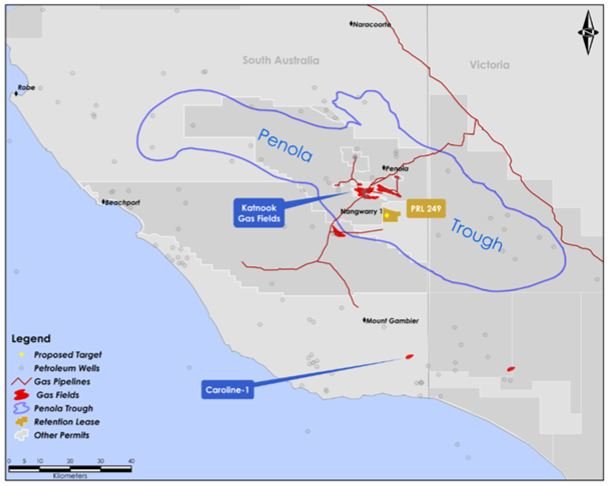
Explore South Australia
Petroleum Retention Licence 249 (PRL 249)
‘Nangwarry Project’
Through its subsidiary, Otway Energy Pty Ltd, Lakes holds 50% of, and operates, PRL 249. Lakes’ net interest in the Licence is 46.76%, after
allowing for minor third-party interests in Otway Energy Pty Ltd.
PRL 249 contains the Nangwarry Carbon Dioxide Project. Discovered in 2020, the Project has a very high (90% or greater) content of pure carbon dioxide, making it attractive for development to produce carbon dioxide for industrial, medical and food uses.
Extended flow testing of the Nangwarry well, carried out in March 2021, showed that the well was capable of producing raw gas at rates up to 18.6 MMscfd, and provided a basis for the following independent verification of the recoverable sales gas volume of carbon dioxide contained within the Nangwarry reservoir.
Nangwarry Project Location
Table: Independently Certified Carbon Dioxide Sales Gas Volume
The Company, with joint venture partner Vintage Energy Pty Ltd, is investigating options for production of food-grade carbon dioxide from the Nangwarry resource. Conceptually, gas production could commence at around 1.5 MMcfd (to produce 75 tonnes per day of carbon dioxide) and grow to 3.0 MMcfd (150 tonnes per day of carbon dioxide).
Pirie Torrens Project
The Pirie Torrens Project incorporates six Petroleum Exploration Licence Applications (PELAs) located in South Australia and covering approximately 53,000km2. Petroleum exploration activities in the general area first commenced in 1956, when Santos was established to drill for oil at Wilkatana. This work, and subsequent drilling by other companies, historically confirmed the presence of oil and gas across the area of interest.
The Company has an arrangement in place with Gehyra Flux Pty Ltd (Gehyra) pursuant to which:
Gehyra has assumed ownership of the six Petroleum Exploration Licence Applications (PELAs) that make up the project. Gehyra is at its cost carrying out work necessary for the PELAs to be granted as Petroleum Exploration Licences (PELs). This includes negotiation of native title matters and agreements.
Gehya will at its cost carry out exploration for hydrogen, helium and petroleum within the area of the PELs.
In the event discoveries are made, Gehyra will pay to Lakes a 2.5% royalty on the value of any hydrogen or helium and a 3.5% royalty on the value of any petroleum produced from the permits.
Gehyra will also pay Lakes an amount of $350,000 (on the earlier of Gehyra achieving official quotation on the ASX or November 2025) and $1.0m on announcement of continuous commercial production of either helium or petroleum.
South Australian Licence Application Areas




